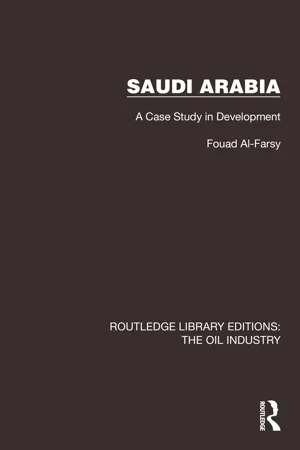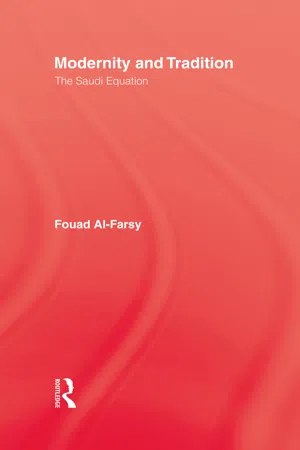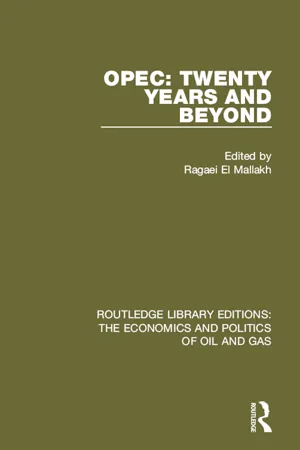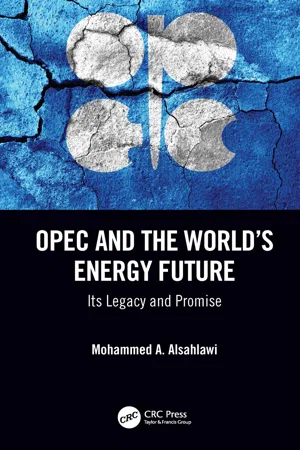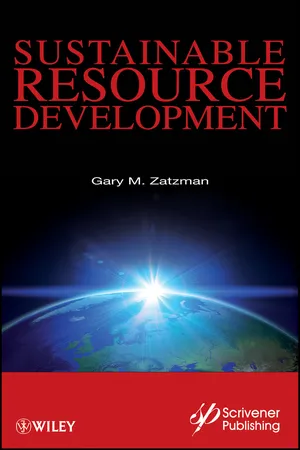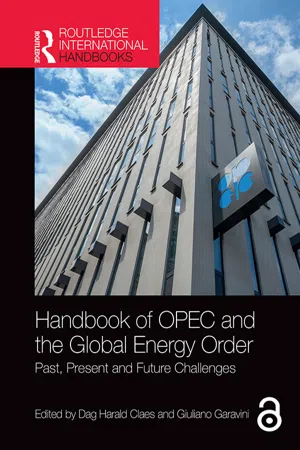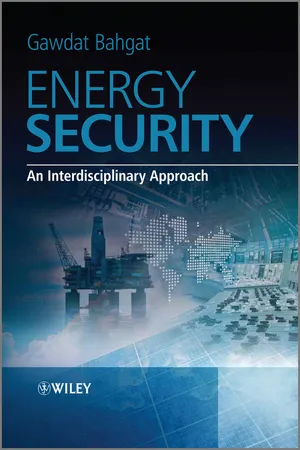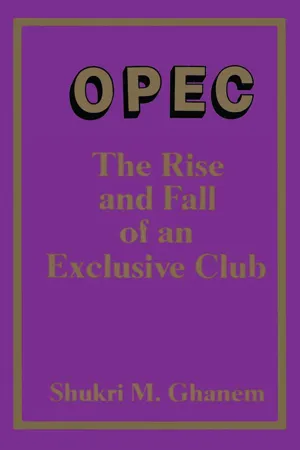Geography
Organization of the Petroleum Exporting Countries (OPEC)
OPEC is a group of 13 oil-producing countries that collaborate to regulate the production and price of oil. Founded in 1960, its members collectively control a significant portion of the world's oil reserves and production. OPEC's decisions have a major impact on global oil prices and the economies of both member and non-member countries.
Written by Perlego with AI-assistance
12 Key excerpts on "Organization of the Petroleum Exporting Countries (OPEC)"
- eBook - ePub
International Organizations and The Rise of ISIL
Global Responses to Human Security Threats
- Daniel Silander, Don Wallace, John Janzekovic(Authors)
- 2016(Publication Date)
- Routledge(Publisher)
10Organization of the Petroleum Exporting Countries (OPEC) Martin NilssonThe 12-member Organization of the Petroleum Exporting Countries that includes Saudi Arabia, Iraq, Iran, the UAE, and Venezuela represents some of the largest oil-producing states in the world. These countries control between 60 and 80 percent of the world’s known oil reserves. OPEC’s primary role is to regulate global oil prices by either reducing or increasing oil production, thereby significantly affecting the crude-oil benchmark (the reference price) of global oil (Colgan, 2014; Kisswani, 2011; Lin, Omoju & Okonkwo, 2015; OPEC, 2015d). As a general rule, OPEC usually does not involve itself in geostrategic or geo-political matters external to its own oil interests (Oil & Gas 360, 2015). With ISIL’s expansion into Syria and northern Iraq, there has been some wide-ranging concern raised internationally by industry heavyweights, politicians, economic pundits, and others on how this might affect the oil prices in the long term (Critchlow, 2015; Hussain, 2014; Oil & Gas 360, 2015). Since the spring of 2015, ISIL has been in control of most of the oil and gas refineries in Syria (itself a small oil and gas producer) and it has expanded its territory into northern Iraq. Baiji in northern Iraq is the country’s largest oil refinery at risk from ISIL operations, and its jihadist affiliates have increasingly threatened the key energy infrastructure in the southern Basra area around the Persian Gulf (see Oil & Gas 360, 2015).Up to the end of 2015, OPEC countries, including Saudi Arabia and Iraq, have managed to maintain high levels of oil production, despite others such as Libya having significant reductions as a result of its ongoing civil war (Elass & Jaffe, 2011; Lima, 2015). OPEC’s ability to effectively manage its oil production would be under threat if the production of the organization’s second largest oil producer, Iraq, were interrupted. This would likely affect the entire price-setting mechanisms of the global oil market. There is little that OPEC can do against ISIL at the organizational level, but its global-market dominance and influence may prompt others to respond against the jihadists and its affiliates, particularly if there is a serious threat to the oil market or prices. - eBook - ePub
- Vasily Simanzhenkov, Raphael Idem(Authors)
- 2003(Publication Date)
- CRC Press(Publisher)
The many applications of petroleum have been known from ancient times. Initially, primitive ways were employed in petroleum operations. Examples include collecting petroleum from the ground surface and the processing of oil sands. The development of the petroleum industry started when mechanical drilling for oil wells for petroleum production was employed in 1859 in the USA. Practically all petroleum extracted in the world now makes use of mechanical drilling.At the moment, there is a reserve of up to 140,000 million tons of economically exploitable petroleum referred to as proven reserves. About 3,400 million tons of crude oil is processed annually in refineries to high-quality finished products. Petroleum has played a very important role in the economy of many countries.In the two chapters (chapters 3 and 4) in part II of this book, the reader will be taken on a trip from the west to the east involving some crude oil producing countries. The influence of the crude oil industry and petroleum organizations such as the Organization of Petroleum Exporting Countries (OPEC) is shown in these chapters.3.1.1 Short Background on OPEC
Before the reader starts on the promised trip, a short history of the most important organization for every crude oil producer is given. This organization is OPEC.All the countries that control the world petroleum market can be broadly classified as the west cartel and the east cartel. The east organization is called OPEC, acronym for Organization of Petroleum Exporting Countries. This organization controls up to 61 % of the world petroleum export. OPEC is a multinational union of crude oil extracting countries. The aim of this organization is to coordinate the oil policy on the world market as well as control petroleum deliveries. This organization was founded in 1960 and now twelve states belong to OPEC: Algeria, Gabon, Indonesia, Iran, Iraq, Qatar, Kuwait, Libya, Nigeria, Saudi Arabia, the United Arab Emirates and Venezuela. Ecuador joined OPEC in 1973 and withdrew its membership in 1992. The main headquarters of OPEC is now located in Europe in Vienna, Austria.The work of OPEC is controlled by half-yearly meetings attended by crude oil ministers or finance ministers of OPEC member countries. Since 1988, there has been the establishment of a ministerial supervisory committee. The aim of this committee is to control and develop new guidelines for crude oil extraction strategy. An economic commission checks the price strategy. Since 1994, a new organ of the OPEC general secretariat leads various research projects, and is also responsible for the legal and administrative questions inside the organization. - eBook - ePub
Saudi Arabia
A Case Study in Development
- Fouad Al-Farsy(Author)
- 2023(Publication Date)
- Routledge(Publisher)
22Source Author’s design Drawn from Abdul Amir Kubbah, OPEC Past and Present, pp 17–18Member States of the Organization of Petroleum Exporting Countries2.1State membership Date of membership Remarks or status Iran September 1960 Founder Member Iraq September 1960 Founder Member Kuwait September 1960 Founder Member Saudi Arabia September 1960 Founder Member Venezuela September 1960 Founder Member Qatar December 1960 Full Member Libya December 1962 Full Member Indonesia December 1962 Full Member United Arab Emirates November 1967 Full Member Algeria July 1969 Full Member Nigeria July 1971 Full Member Ecuador November 1973 Full Member Gabon December 1973 Associate Member OPEC’s headquarters were in Geneva, Switzerland, from January 21, 1961, through August 1965, but, in the latter year, moved to Vienna. Both sites were chosen because of the host country’s political neutrality.As can be seen from Table 2.1 , only seven of OPEC’s thirteen members are Arab states.The criteria governing the admission of new member states are set forth in Article 7, para. C., of OPEC’s statute of November, 1971:Any other country with a substantial net export of crude petroleum, which has fundamentally similar interests to those of Member Countries, may become a Full Member of the Organization, if accepted by a majority of three-fourths of Full Members, including the concurrent vote of all Founder Members.23For a state to qualify, it must first possess a “substantial net export of crude petroleum”. Secondly and more significantly, the state applying for membership must “[have] fundamentally similar interests to those of Member Countries”. - eBook - ePub
- Fouad Al-Farsy(Author)
- 2012(Publication Date)
- Routledge(Publisher)
These two successive unilateral and arbitrary cuts in 1959 and 1960 by the petroleum companies operating in the Middle East were important determinants towards establishing OPEC. They “generated a feeling of economic insecurity in oil exporting countries and emphasized the need for a collective defense to arrest the downward drift of prices and government-per-barrel revenues”.Source: IbidStructural organization of OPECThe governments of Saudi Arabia and Venezuela, in accordance with the objectives of the Arab Petroleum Congress of 1959, issued a declaration on 13 May 1960, recommending that petroleum exporting countries pursue a common policy in order to protect their rightful interests. The declaration also advanced the idea of establishing an organization to achieve this end. None the less, the countries concerned did not take immediate action. It was the sudden and arbitrary decrease in petroleum prices for the second time in 1960 that made them feel the danger which encouraged them to unite in a common front. Consequently, the major petroleum producing countries declared, after the Baghdad Conference of 10-14th August 1960 (at which the Kingdom of Saudi Arabia, Republic of Iraq, Iran, Venezuela and Kuwait were represented), their intention to establish the organization which became known as the Organization of Petroleum Exporting Countries (OPEC). One of the major decisions of that meeting declared a cardinal objective of the organization to be the standardization of petroleum prices among its members and agreement on the best methods of protecting its individual and collective interests. As a result, OPEC was founded in September 1960as a permanent intergovernmental organization with an international status. In accordance with Article 102 of the United Nations Charter, the agreement creating OPEC was duly registered with the Secretariat of the United Nations on November 6, 1962, under No. 6363. [Moreover, it is quite important to refer to the fact that] OPEC is not a business entity; it does not engage in any commercial transactions. [It concerns itself with the formulation of a common policy toward the industrialized countries of the world and the fixing of petroleum prices in a unified manner.] The legally authorized representative of the organization is its Secretary General. The staff of the Secretariat are international civil servants. - eBook - ePub
- Ragaei el Mallakh(Author)
- 2016(Publication Date)
- Routledge(Publisher)
In view of this, major consuming developed countries should pursue a more vigorous policy aimed at: (a) eliminating all forms of waste stemming from irrational uses of hydrocarbons; (b) revising production and transformation structures in order to eliminate sizable existing losses in conversion and transportation; and (c) integrating into the system other energy sources that can contribute to the energy balance. A rational approach for consuming hydrocarbon resources entails a global integration of all parameters involved, based on a reasonable appreciation by the consumers of the requirements of the producers.This may now be the appropriate moment to sketch out the role of the Organization of the Petroleum Exporting Countries (OPEC) in the future supply of oil. It is felt necessary that the life-span of OPEC’s hydrocarbon reserves should be extended for as long as possible, so as to provide its member countries with the necessary time to transform their depletable deposits into permanent assets through development and industrialization and later to feed the industries created.The necessity, however, to place future production in such a way as to ensure that OPEC can come to be regarded as a reliable, long-term supplier rather than a mere buffer on the international market, is becoming increasingly obvious.It is worth mentioning here that after 1973, when people started talking about the drastic redistribution of resources to the advantage of our member countries, they omitted to mention the fact that these resources had not yet been transformed, except to a very small extent, into wealth. Today, some of our member countries with increased foreign exchange at their disposal are encountering serious difficulties in converting the value of their oil exports into real wealth, while other nations are becoming heavy borrowers in the international financial centers in order to be able to achieve their development aspirations.Most OPEC states still require a long time to accomplish this transformation, while those that had a greater capacity for economic growth have seen this capacity diminish drastically due to the fact that unfavorable terms of trade have placed considerable constraints on their development. Surely everyone will agree that accumulating large bank deposits, quite apart from the possibility of using them to produce more income for the country concerned, corresponds neither to the best conservation criterion nor to the best development policy. In this regard, the developed nations have a moral obligation to assist in accelerating the development process of our developing countries through the adequate and timely transfer of modern technology. - eBook - ePub
OPEC and the World's Energy Future
Its Legacy and Promise
- Mohammed A. Alsahlawi(Author)
- 2021(Publication Date)
- CRC Press(Publisher)
Due to persistent arguments and pressures from OPEC, and governments of oil producers, the companies accepted to discuss oil issues with the host governments. The major outcome was the agreement by the oil companies to re-calculate taxes and royalties on the basis of posted rather than realized prices. The OPEC success continued in the following years, until OPEC assumed the “sovereign right” for its members to manage their oil and petroleum resources.Another success was the release of the Declaratory Statement of Petroleum Policy in Member Countries in the June 1968 meeting, which allowed OPEC countries to go into direct exploration and development.As oil prices increased, non-OPEC production increased while overcoming the high cost of production. This caused OPEC to play the role of residual supplier and act as price administrator in order to protect price stability, even when OPEC’s market share was eroded. In the process of OPEC trying to find its way, it continued to interact with oil companies, consuming countries, non-OPEC producers, and other international organizations such as the United Nations (UN), World Energy Council (WEC), International Energy Agency (IEA), and the Organization of Economic Cooperation and Development (OECD). In most OPEC conferences and important meetings there were representatives from these organizations.Before instituting what was known as “OPEC and non-OPEC dialogue”, OPEC organized a joint ministerial meeting between OPEC and the key Independent Petroleum Exporting Countries (IPEC) in Muscat, Oman on April 13, 1993. The IPEC/OPEC ministerial meeting was attended by 12 OPEC members countries and by 14 IPEC producers, among them the Russian Federation, Norway, Mexico, Malaysia, China, and the State of Texas. Some attended as observers from international organizations. The meeting reviewed the long-term energy and oil-market outlook in light of different policies concerning the environment and investment prospects in both the producing and consuming countries. One of the important policies pertained to OPEC and other petroleum exporting countries; there was the issue of imposing a carbon and energy tax by consuming countries. Overall, the meeting called for more cooperation among producers and consumers which eventually materialized in producer-consumer dialogue which was implemented in the 1990s and after. - eBook - ePub
The Community of Oil Exporting Countries
A Study in Governmental Co-operation
- Zuhayr Mikdashi(Author)
- 2023(Publication Date)
- Routledge(Publisher)
opec was established as a ‘defensive’ mechanism to form a common front vis-a-vis expatriate oil firms and major oil importing countries. opec ’s concern, therefore, is not regional integration of members’ economies and societies, but mainly the co-ordination of members’ policies in one commodity, petroleum, and solely in the export market. In contrast, the Organization of Arab Petroleum Exporting Countries (oapec) has, as its ultimate goal, the integration of its members’ national economies into a single regional economy. A. Measuring Compatibility Among the large number of parameters and variables relevant to opec co-operation, 1 some have dominated discussions of the joint regulation of production; area, population, oil reserves, amount and growth of oil production, production costs, oil revenues, factor endowment (other than oil), and a country’s dependence on the oil industry. Other variables relevant to co-operation among opec countries include the education and expertise of elites and political leaders, and their values, goals, and priorities. Variations among opec countries in socio economic systems, in international economic relations, in foreign alliances, in ideology and degree of dogmatism, and in political stability will also affect these countries’ views and actions on common problems. Among the latter variables, political stability may defy ready measurement, since it contains a high proportion of intangibles and unknowns. However, the chairman of The ‘ Shell ’ Transport and Trading Co. Ltd, the 40 per cent owner of Royal-Dutch Shell, has said that his company was ‘quantifying’ political risks, but he would not elaborate on the techniques used. 2 In addition to identifying critical factors relevant to opec cooperation, there is also the question of ascertaining their relative weights. A number of the variables suggested above are interrelated - eBook - ePub
- Gary M. Zatzman(Author)
- 2012(Publication Date)
- Wiley-Scrivener(Publisher)
At OPEC’s founding, national oil companies were very much the exception, not the rule. Nationalization of foreign oil companies’ operations in OPEC states was never mentioned again publicly after the CIA overthrew the Mossadeq government in Iran in 1954 for even suggesting such an outrageous course. Of course, this meant that the oil-producing states were largely bereft of agencies dedicated to planning the current and future rates of exploitation of their energy resources. In the absence of such capabilities, oil-producing states even after the founding of OPEC continued to struggle to protect actual reserves of oil from the claims of global demand from the international oil companies. OPEC members were thus placed in a position of being unable to work out and develop production according to a program that would protect the future of their resource wealth going forward. Thus while they could verbally aspire to achieving sustainable levels of energy resource development, they had no way to plan the future accordingly much less a plan that they could defend and implement to that end.Many are prepared to accept that OPEC is definitely part of the story of current energy pricing theory and practice. However, there is far less clarity about what possible role this organization and its continued existence could play with regard to an alternative such as “sustainable development.” It is an important result of the closing of the political spectrum from Right to Left alluded to above that people’s ability to see such a prospect as “sustainable development” has actually come under attack. From the right side of the political spectrum, the opinion that OPEC is a collection of greedy sheikhs prevails, while from the Left comes an accusing sneer that OPEC member states are suffering the consequences of failing to fully nationalize their oil wealth as part of building socialist commonwealths across the largely Muslim deserts of northern Africa and western Asia!During OPEC’s lifetime, the world has spawned the “Group of 77,” the Non-Aligned Movement of 120 member- and 21 observer-states, and some other less formal groupings. Whether the resource is agricultural or mineral — cocoa, sisal, cane sugar, rare metals and precious minerals — this trend has been seen throughout the developing states of Africa, Asia and Latin America. All these have emerged in response to unacceptable demands imposed by privately-owned global monopolies operating essentially as cartels. Were OPEC just another grouping of self-interested commodity producers, could such a development even have been anticipated? All these other anti-cartel groups pay first-rate attention to how OPEC navigates the various storm fronts that blow up throughout the global economy. Waxing and waning with the cycles of expansion and contraction in an increasingly globalized economy, the development in depth and breadth of such counter-cartel concertation, in one commodity after another produced by the monocultural economies of the global South, stands as a living refutation of both the contemptuous dismissals from conventional economists from the Right and the obtuse denial by the minority on the “Left” of any agency on the part of developing countries to maneuver within the extremely unjust mandates of the globalized marketplace in defence of their respective nation-building projects. The U.S. and the European Union have generally been opposing this phenomenon with confrontation and ultimatums. China usually seeks collaborative relationships as a starting-point in its relations with these organizations. Post-Soviet Russia sometimes supports and sometimes opposes OPEC on oil price trends, sometimes seeks collaborative arrangements with some of these other cartels, and has even tried to launch its own semi-cartelized “anti-cartel” in the global natural gas market. - eBook - ePub
- Dag Harald Claes(Author)
- 2018(Publication Date)
- Routledge(Publisher)
OPEC members nationalized their oil production. This made the relationship to the international companies of lesser importance, or, more correctly, made the international oil companies less important for the developments in the oil market. Consequently, “the other,” having been one of the main reasons for the establishment of the organization, was no longer an important factor.Regarding the relationship with other actors wanting to join the organization, the potential new members were restricted by Article 7c of the Statutes, which provides that “any other country with a substantial net export of crude petroleum which has fundamentally similar interests to those of Member Countries, can become a Full Member of the Organization.… No country may be admitted to associate membership which does not fundamentally have interests and aims similar to those of member countries” (OPEC 1990:33). This is an example of what Cox and Jacobson (1973) call a boundary-decision, creating criteria for who can be included in the organization and who cannot. The Statutes suggest that countries with a substantial net export of crude petroleum have some objectives in common. They also set clear criteria regarding what kind of countries OPEC is set to represent. Such statutes obviously create a common identity among the OPEC countries.Creating common identity by being an example for others means that the members of OPEC might find it harder to leave or obstruct the working of an organization that has become an ideal for other Third World countries seeking to better their position against the industrialized countries through similar collective action.When OPEC succeeded in raising the price of crude oil, it seemed the beginning of a broader change in the relationship between the raw material producers in the south and the industrialized countries in the north. “After the events in the fall of 1973, OPEC became a model, radically strengthening the belief in the effectiveness of producer-exporter cooperation as a means of promoting the interest of the periphery countries” (Hveem 1977:15). The OPEC summit of heads of state in Algiers in March 1975 was the peak of the role of OPEC as “the shield of the Third World,” as the banners in the city proclaimed (Terzian 1985:213). Algerian authorities submitted several “draft resolutions” covering, among other issues, an international conference on raw materials and development, a declaration dealing with the international monetary system, a kind of defense pact between OPEC members, and a project for an OPEC fund for development and international cooperation (Terzian 1985:213-214). The OPEC special fund was set up in 1976, providing “interest-free long-term loans to developing countries” (OPEC - eBook - ePub
Handbook of OPEC and the Global Energy Order
Past, Present and Future Challenges
- Dag Harald Claes, Giuliano Garavini, Dag Harald Claes, Giuliano Garavini(Authors)
- 2020(Publication Date)
- Routledge(Publisher)
3Saudi Arabia’s role in OPEC’s evolution
OPEC and the global energy order from its origins to the present time
Majid Al-MoneefThe relationship between the Organization of Petroleum Exporting Countries, OPEC, and Saudi Arabia and their respective roles in the international oil market have dominated the literature on OPEC’s behavior since 1974 until today. Commentators and market watchers continued for decades to emphasize the dominant position of Saudi Arabia in OPEC since its inception. This role is derived from its weight in OPEC’s reserves and overall production and exports, the relative stability of its supplies throughout and its readily available excess production capacity to mitigate supply interruptions. The relative political stability of Saudi Arabia was reflected among other things in the consistency of its oil policy and the longevity in office of its oil ministers, which contributed to the effective utilization of its role in OPEC and the market.1A whole line of economic literature used the dominant firm hypothesis to model OPEC behavior, postulating that Saudi Arabia either alone or in association with its Gulf partners dominated OPEC’s pricing and production decisions. Another line of research used the game theory approach to model Saudi Arabia’s relations with the other members in devising the latter’s role in the market. Others sought to emphasize the political factors contributing to Saudi Arabia’s decision-making process within the Organization.2Needless to say, as the market evolved over the decades, so did the Saudi position and role within OPEC, the effectiveness of the organization and the Saudi policy approach to it. However, such a role was also influenced by its political relations with the other members, the market environment, the international political scene and Saudi Arabia’s internal politics. At different critical market junctures, Saudi Arabia’s role was critical, beginning with the events contributing to the birth of OPEC and the process of building the organization during its early years, its assumption of market management role in the seventies, its declining market power in the eighties and its re-established market role since the beginning of the 21st century. - eBook - ePub
Energy Security
An Interdisciplinary Approach
- Gawdat Bahgat(Author)
- 2011(Publication Date)
- Wiley(Publisher)
Within this context, natural gas has been widely considered the fuel of choice for many consumers. It is abundant and less polluting than coal or oil. Little wonder that natural gas consumption and trade have expanded in the last few decades. Consumers in the United States, Europe, and Asia have grown more dependent on natural gas. Domestic production in these regions, however, cannot keep pace with rising demand. This large and growing gap between demand and domestic production has been increasingly filled by imports from foreign suppliers. The deepening dependence on foreign sources has heightened concerns about security of supply. Stated differently, natural gas consumers are increasingly concerned about potential movements by major gas producers to influence gas markets and prices, similar to the role of OPEC in oil markets. Will a “Gas OPEC” emerge?On the supply side, natural gas producers have sought to coordinate their policies in order to strengthen their position in negotiating prices and terms of trade with consumers. In a meeting held in Tehran in May 2001, some major gas producing nations created an organization called the Gas Exporting Countries Forum (GECF) to facilitate such cooperation. Since then, some hawkish members, such as Iran and Venezuela, have sought to transform the GECF into Gas OPEC. Others (i.e., Algeria and Qatar) believe it would take some time for such a transformation to take place. Meanwhile, Russia, the major gas producer and exporter, has taken an ambivalent stand, sending conflicting signals.In this section, I examine the prospects for the evolution of the GECF into Gas OPEC. I argue that gas producers are likely to continue and expand their cooperation. Such cooperation, however, is unlikely to involve attempting to control output or influencing prices like OPEC does. This low probability that the GECF would evolve into Gas OPEC is based on major differences between the oil and natural gas markets. In addition, Russia is not likely to play a leading role in forming a Gas OPEC, similar to the Saudi leading role in OPEC.9.6 GECF and OPECAs discussed above, when OPEC was founded the oil trade was characterized by bilateral long-term contracts and oil producers were not satisfied with the low financial returns they were getting for their crude. At the outset, OPEC looked weak and did not have the powerful leverage it came to exert on oil output and prices in the following decades. The 1973 Arab–Israeli War and the subsequent use of oil as a “political weapon” was a turning point in the history of OPEC and the oil industry. Two factors contributed to strengthening OPEC’s bargaining position. First, in the early 1970s, US oil production peaked and Washington began its steady reliance on foreign supplies. Second, oil was almost the primary fuel in the transportation, residential, and industrial sectors, providing almost half of global energy requirements [17]. In the early 1980s, OPEC initiated a production-quota system. Such a move has enabled OPEC to adjust its overall production in response to signals from global oil markets. - In accordance with the statute of the organisation the Chairman of the Board of Governors and the Secretary General used to be occupied by one person . This was changed when the statute was amended in April 1965.
References
- Alfonzo, Perez (1966) OPEC Monthly Bulletin . Ministry of Mines and Hydrocarbons, Caracas, 1 (1).
- Baghdad (1960) Resolutions of the first conference held in Baghdad .
- Economist (1960) ‘Who is talking?’
- Economist (1961) ‘Issues in Iraq oil.’
- Frankel, Paul (1962) Mattai, Oil and Power Politics , New York, Praeger.
- Lufti, Ashraf (1968) OPEC Oil , Beirut. Middle East Research and Publishing Centre.
- Middle East Economic Survey (1960) Sep 16.
- Mikdashi, Zuhayer (1972), The Community of Oil Exporting Countries , New York, Cornell University Press.
- Monthly Bulletin (1967), ‘Address of the Venezuelan Minister of Mines and Hydrocarbons to the Venezuelan Senate’, Ministry of Mines and Hydrocarbons.
- O’Conner, Harvey (1962) World Crises in Oil , New York, Monthly Review Press.
- OPEC (1961) ‘The amended status of OPEC ’.
- Petroleum Press Service (1964), London.
- Tehran (1961) ‘Press conference of the Shah 1960-1961’. Office of information .
- Tugendhat, Christopher (1968) Oil, the Biggest Business . New York, G. P. Putnam and Sons.
Passage contains an image
Chapter Three Membership and Members of OPEC
DOI: 10.4324/9781315829012-5One of the most important reasons for calling the first meeting of the petroleum ministers in Baghdad was the desire of General Qassem of Iraq to curb the influence of Egypt over oil which was growing as a result of holding the first Arab Petroleum Congress in Cairo and the recommendation of that congress to establish a committee to prepare a charter for an ‘Arab Petroleum Organisation’. This is why the second resolution of the Baghdad conference limited the membership of the organisation to the countries represented at that conference. They were Iraq, Iran, Kuwait, Saudi Arabia and Venezuela. However, any country with a substantial net export of crude petroleum could become a new member if unanimously accepted by all five original members of the organisation. This in fact closed the door completely to Egypt which, at that time, was not even self-sufficient in oil.
Index pages curate the most relevant extracts from our library of academic textbooks. They’ve been created using an in-house natural language model (NLM), each adding context and meaning to key research topics.
Explore more topic indexes
Explore more topic indexes
1 of 6
Explore more topic indexes
1 of 4


